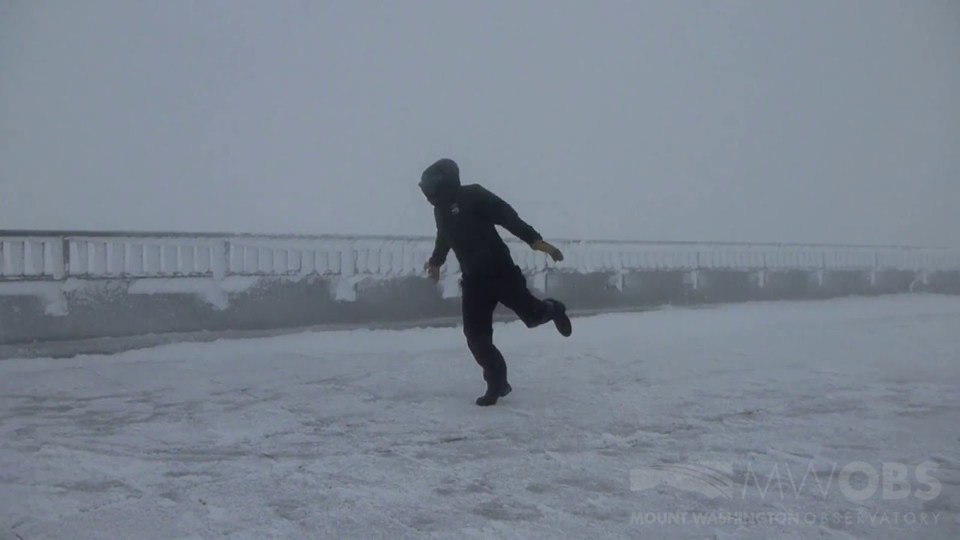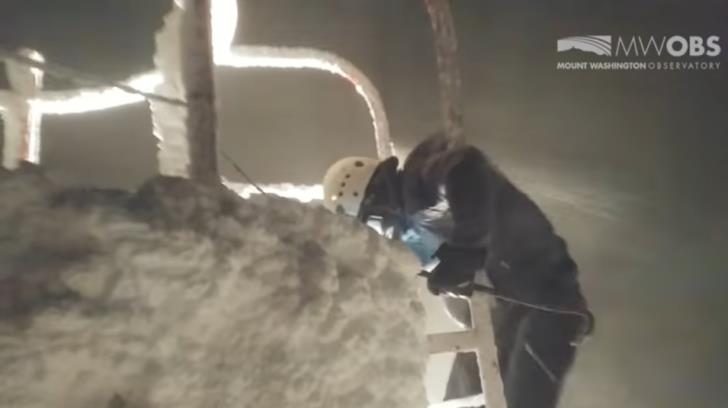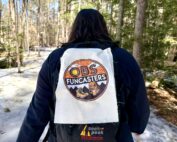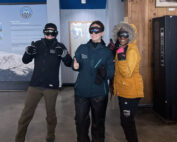(Don’t) Blow Me Away!
2018-02-08 14:31:01.000 – Sarah Schulte, Summit Intern
If you Google images or video for the Mount Washington Observatory, you’re going to find a lot of clips and pictures about our observers being blown backwards, knocked flat and pushed around. As fun as is this is to watch, it does raise a few questions concerning safety. During my first week here, I’ve heard some specific questions asked and, not originally knowing the answers myself, I wanted to share them with you all!
Has anyone ever been blown off the mountain?
Despite how high the winds can get at the summit, no one has ever been blown off the Rockpile. With the winds blowing horizontally across the deck and the force of gravity acting downward, movement is also downward. Because of this, a gust of high wind won’t pick your body up and throw you through the air; instead, it’s going to knock you down and push you along the ground like a curling rock. In one particular YouTube video, observer Mike Dorfman jumped into 100+ mph winds and was immediately punched back to the ground! Since the Observatory deck (where we perform observations) is railed, you can’t be pushed over the side once you’re down. There are also structures on the deck, such as the instrument tower and the A-frame, that allow observers some shelter from the wind if it’s interfering with their observations.

Observer Mike Dorfman taking a falling leap.
Why don’t you tie yourselves down?
We don’t wear lines when we go outside because a rope would actually present more safety issues than if we went out untethered. If the winds are high enough to knock people over, then they’ll also whip the rope around, where it could snap back and hit us. Worse, it could trip us up or get tangled around us, potentially becoming very dangerous.
So what precautions do you take?
One of the main concerns in high winds is the temperature. With the average yearly temperature at the summit being below freezing (27.3⁰ F!) and the average yearly winds hitting 35mph, wind chills can drop dangerously, posing a risk of frostbite to any exposed skin. Observers go out dressed in several wind- and water-resistant layers with their hoods secured beneath the straps of their goggles and any loose strings tucked in so that they don’t whip around.
Another hazard is flying rime ice, and this is where the goggles are vital. Rime ice is very light, and it can break off and fly around in large chunks. If there’s ice flying around, the observers will wear helmets, and the goggles keep small, high-speed ice slivers out of their eyes.

Observer Caleb Meute de-icing the tower instruments.
You don’t have to work at the top of a mountain to experience frostbite and flying debris, and with the unpredictability of New Hampshire’s mountain weather, it’s always wise to check the weather before venturing out onto the trails. It’s better to be over-prepared than under-prepared.
Working at the Observatory can be physically taxing and unpredictable, but with proper training and safety considerations, the rewards are fantastic: an 85-year long (and growing) collection of weather data, stunning pictures and the exhilaration of experiencing weather that few people see in their lifetimes. There’s nothing like standing at the summit of the Northeast’s tallest peak and daring the weather to do its worst!
Sarah Schulte, Summit Intern
Team Flags Return for Seek the Peak’s 25th Anniversary
Team Flags Return for Seek the Peak's 25th Anniversary By MWOBS Staff Mount Washington Observatory is looking forward to continuing a much-loved tradition for Seek the Peak’s 25th Anniversary: Team flags. In inviting teams
Meet Summer Interns Zakiya, Max and Maddie
Meet Summer Interns Zakiya, Max and Maddie By MWOBS Staff We are excited to welcome six teammates to the summit of Mount Washington this summer! During their internship, these students and graduates will play
Saying Goodbye to the Summit
Saying Goodbye to the Summit By Alexis George After an extraordinary last three years working as a Weather Observer and Meteorologist, I am excited to pursue a different career. As sad I as am




